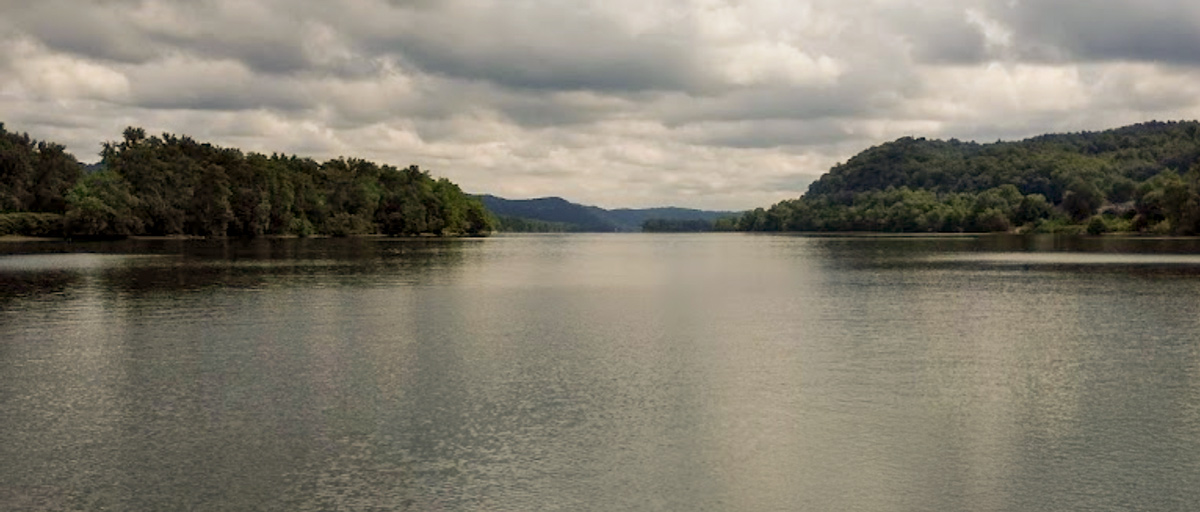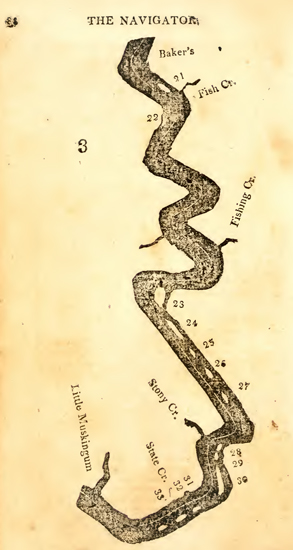To pass through a shallow spot in the Long Reach of the Ohio, the crew must cut a channel through the gravel. They anchor about nine miles upstream from Marietta, Ohio.
From Wheeling, fellow traveler Thomas Rodney writes a letter describing the low water and Lewis’s journey down the Ohio to that town.
This map, from the 1814 edition of Zadok Cramer’s Navigator was not included in the edition that Lewis took with him in 1803. Without maps, the earlier pilots often had difficulty identifying Cramer’s landmarks. This is certainly true of Thomas Rodney who traveled at the same time as Lewis and also used an earlier edition of the Navigator. This type of confusion may be the reason that Lewis’s descriptions of the morning’s camp and Wilson’s Riffle appear contradictory.[1]See Moulton, Journals, 1:80n1. This map labels the following landmarks:
23: Peyton’s Island
24: Williamson’s Island
25: Pursley’s Island
26: Wilson’s Island
27: John Williamson’s Island
28: Little Island
29: Bat Island
30: Middle Island
31–33: Three Brothers Islands[2]Zadok Cramer, The Navigator: Containing Directions for Navigating the Monongahela, Allegheny, Ohio and Mississippi Rivers… (Pittsburgh: Cramer, Spear and Eichbaum, 1814), 37–41.
Cutting a Channel
set out at sunrise it began to rain and continued with some intervals untill three in the evening passed several bad riffles and one particularly at the lower end of the long reach called Willson’s riffle here we were obliged to cut a channel through the gravel with our spade and canoe paddles and then drag the boat through
—Meriwether Lewis
The Long Reach
The long reach is a strait course of the River for abt 18 or 20 Miles which appears the more extraordinary as the Ohio in general, is remarkably crooked — there are several Islands in this reach, some containing an 100 or more Acres of Land; but all I apprehend liable to be overflowed. —
We found the bottom increased in size, both as to length & breadth & the River more Chokd up with Fallen Trees, & the bottom of the River next the Shores rather more Muddy but in general stony as it has been all the way down
—George Washington (October 25 and 26, 1770)[3]Archer B. Hubert, “Washington’s ‘Tour to the Ohio’ and Articles of The Mississippi Company.” Ohio Archaeological and Historical Society Publications, (October 1908), 462.
Rodney’s Update
On his way to the Mississippi Territory, Thomas Rodney writes a letter to Thomas Jefferson with news of Lewis’s trip thus far.
Wheeling Monday Septr. 12th. 1803.
Dr Sir
. . . . .
It is Said by those who reside here that they Never saw less water in the Ohio—many Riffs or shoals have not more than 15 or 18 Inches water over them, but as our Batteau will not draw more than 8 or 10 Inches water none of them will Stop us.
Captn. Lewis left here on Fryday last—he had some trouble in Coming from Pittsburg down here by having to unload and to have his Barge drawn by Oxen over several riffs or Shoals—before he left here he made his boat as light as possible by putting his lading in several Canoes—we heard of him after he had passed 16 miles below this, when he had passed Several of the worst riffs or Shoals below this place without their stoping him and probably he will Soon reach better waters—yet as Our Boat is much Lighter than his we Expect to Overtake him before he gits out of the Ohio. With Sentiments of the highest respect and Esteem I remain
Your Most Obedient
Thomas Rodney
Experience the Lewis and Clark Trail
The Lewis and Clark Trail Experience—our sister site at lewisandclark.travel—connects the world to people and places on the Lewis and Clark Trail.
Plan a trip related to September 12, 1803:

Notes
| ↑1 | See Moulton, Journals, 1:80n1. |
|---|---|
| ↑2 | Zadok Cramer, The Navigator: Containing Directions for Navigating the Monongahela, Allegheny, Ohio and Mississippi Rivers… (Pittsburgh: Cramer, Spear and Eichbaum, 1814), 37–41. |
| ↑3 | Archer B. Hubert, “Washington’s ‘Tour to the Ohio’ and Articles of The Mississippi Company.” Ohio Archaeological and Historical Society Publications, (October 1908), 462. |


